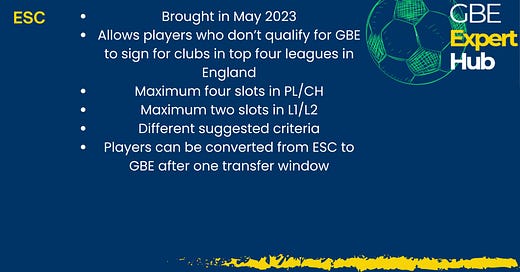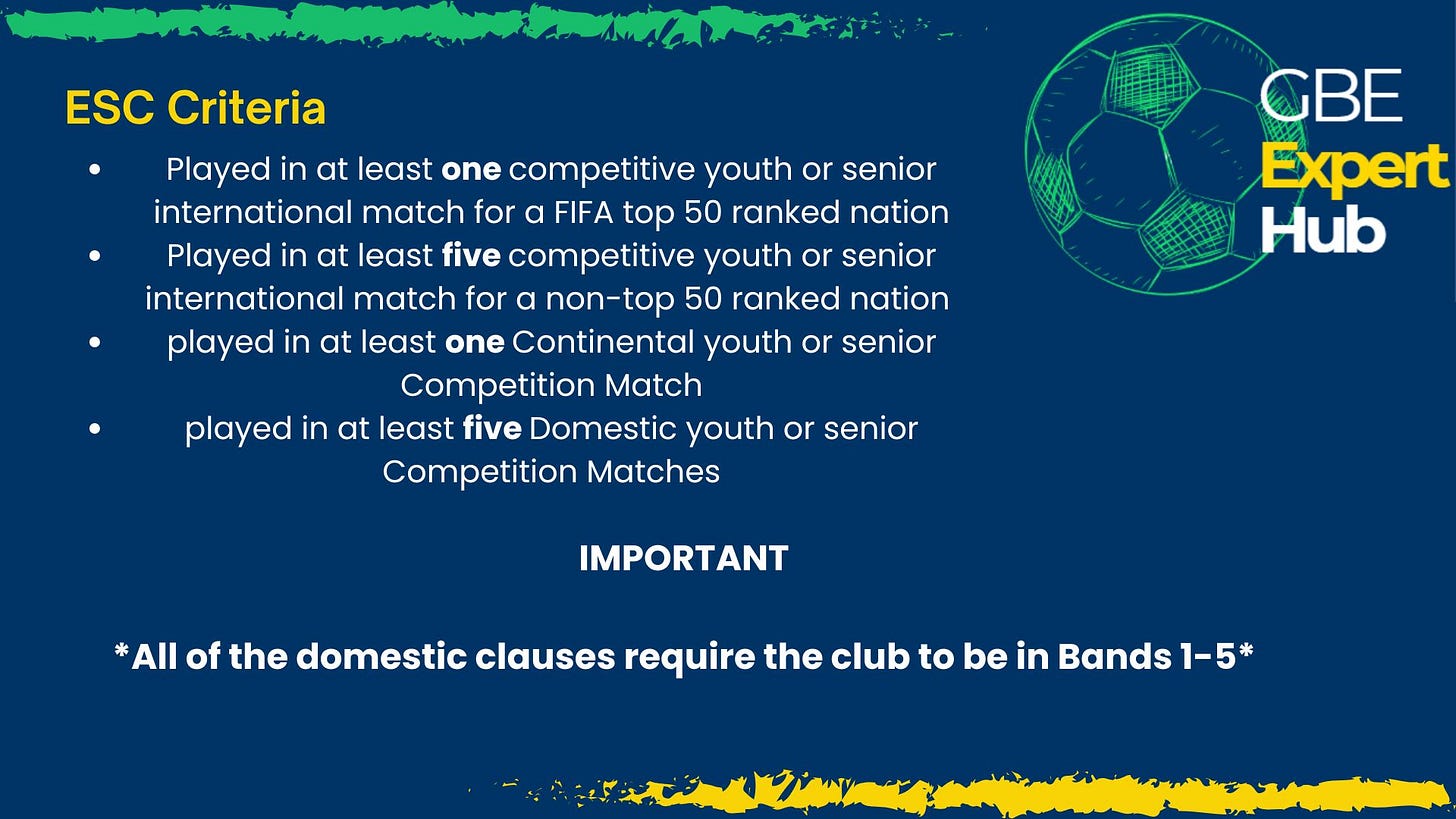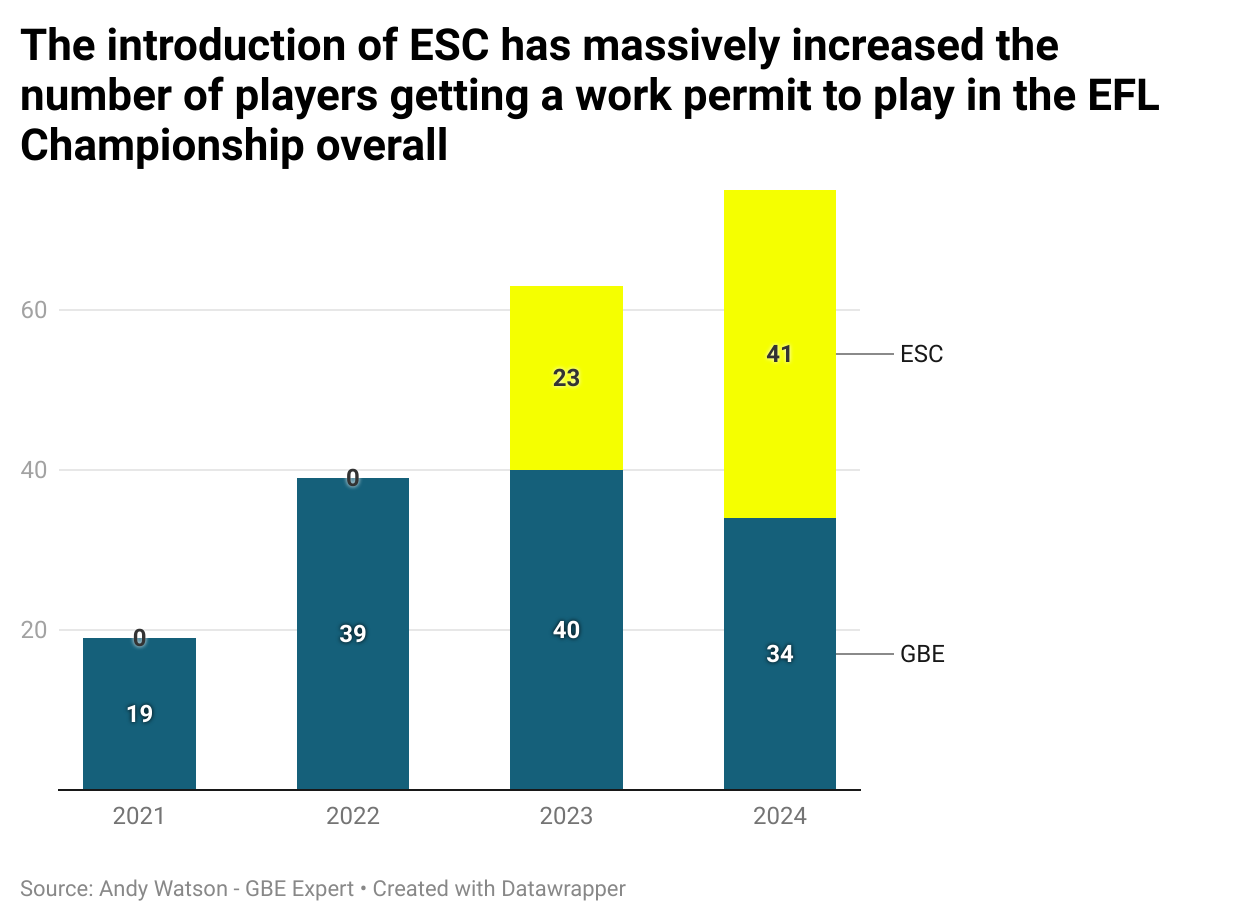So, as of yesterday, we now know the basics of the GBE system in the UK.
In June 2023 there was something of a shake-up of the rules and regulations issued by The FA for clubs in England. The introduction of something called Elite Significant Contribution (ESC) changed the game in terms of recruitment for English clubs.
There had been murmurings of discontent around the Premier League that the GBE rules were giving the clubs in the top tier of English football a significant disadvantage in the transfer market, when compared to the likes of Serie A, La Liga, Bundesliga, and Ligue 1 clubs. The idea being that because of the fact that players had to be established internationals, or gain 15 points in the criteria, that PL clubs basically had to wait longer to be able to sign talented players than their counterparts in other major European leagues.
It was against this scene that the Home Office approved the biggest change to the GBE legislation since its inception in December 2020. The introduction of ESC meant that players who would previously have not qualified for a GBE would be available under certain circumstances.
I can tell that you are excited about this…
What is ESC?
It is probably best to think of ESC as a side door to a holding pen, though maybe a nice first-class lounge rather than a farm-style pen.
The ESC legislation basically allows a team in England, this does not apply in any other UK country at the moment, to hold the registration of a player who does not qualify for a full GBE, i.e. they are not in receipt of an autopass and nor do they reach the 15pt threshold.
However, each club in the top four divisions has a limited number of slots for these ESC signings. The Premier League and EFL Championship clubs receive a maximum of four slots each, with EFL Leagues One and Two receiving a maximum of two slots per club.
The number of slots a club has available at any one time is dependent on the number of ESC signings they currently have registered at the club, but also, on the percentage of minutes that they grant to their English Qualified Players (EQPs). The table below is a simple illustration of the percentage of minutes that clubs need to give to EQP in order to retain a certain number of ESC slots.
This was the FA’s attempt at retaining some level of control over the number of English players who could’ve been playing in the professional game in their own country.
There are other clauses in the documentation that have some influence over a team’s slots, but that is slightly too much detail for a basic overview.
Point to note:
It is also important to mention ESC conversion at this stage. A player can be converted to full GBE status after one transfer window i.e. if a player is signed in summer then they can be converted in the following February.
This can happen if either:
The player is now able to hit 15 points in the GBE calculations, or has played enough international football to receive an autopass
The player has played a certain percentage of minutes for the club over the period of time that they have played for the club. For Premier League clubs, there is a differentiation of what percentage of minutes a young player needs to play (see table below).
The obvious benefit to conversion is that a club then has an ESC slot back again, and the player is a more valuable commodity because they have a full work permit to work in England.
How does a player qualify for ESC?
There are a number of criteria, though in the literature it does say that the club has to evidence that the player in question is an elite player and will make a significant contribution to the sport.
However, the FA then go on to outline the minimum requirements for an ESC player, which is to have satisfied one or more of the criteria in the image below.
Automated calculators for ESC status are much more difficult to come by, and much more difficult to code, owing to their widespread nature, and the difficulty to come by certain data.
The GBE Expert Hub can look into every player’s history to ascertain if the player qualifies for an ESC. Indeed, this can be a very powerful tool for foreign clubs and foreign agents to establish which of their players could be open for moves to England. Many more players than you might expect are potentially available.
Point to note:
There is no centralised resource for anyone in public to see which transfers have been put through as ESC or, indeed, as GBE. This can make it very difficult to work out what the current situation is in terms of the number of ESC slots teams in England are using at any one time.
The GBE Expert Hub has a potentially unique data set on which clubs still have slots to use and which are currently using them with some of the players in their squad. If you would like to access this list then please get in touch.
How much influence has ESC had in the market so far?
It depends on the level. As we often see when certain things change in the legislation it can take around twelve months for the effects of the changes to be used effectively by recruitment teams.
The diagram below demonstrates how the usage of the ESC has changed in each of the transfer windows that it has been available.
In 2024, The GBE Expert Hub estimates that to their best knowledge, there were 62 ESC transfers conducted into England. 23 out of 24 Championship clubs used an ESC, but only 10 Premier League signings were made under the ESC regulations, which is actually fewer than the first season that it was introduced, though we still have the January window to go in the 2024/25 season.
This goes against the usual trend of it taking around a year for adaptations to the rules to be adopted by recruitment teams, and calls into question the usefulness of the ESC regulations for Premier League teams. It will be interesting to see what happens in the future of PL recruitment as regards the use of ESC.
In the Championship, however, the use of ESC has been transformative.
The ESC legislation has led to the number of overall work permit transfers almost double from 2022/23, pre-ESC. Indeed, in the summer just gone there were more transfers conducted by ESC than direct GBE applications.
It is clear that the introduction of ESC has been great for enabling those second tier clubs to bring in non-world class talent, and it remains to be seen what the long-term implications of this will be. It is my contention that the clubs that manage the ESC process the best during this period will be the teams that are ultimately the ones who can make the most progress on the pitch.
How can clubs maximise their ESC recruitment strategy?
This is the absolute key question. Correct usage of the ESC system could be a key differentiator on who recruits well and who doesn't over the next few seasons.
It is a well known issue for EFL teams that so much is now known about all domestic players, even at U18 and U21 levels, and increasingly even younger than that. Every member of every EFL squad is a fairly known quantity, and, yes, this can have some positives, many risks will be reduced, but how much progression can be made in this way?
Exploring new markets, with less potential competition, and also reaping the benefits of a much bigger pool of players can turbo charge the quality of a squad in the EFL. However, talent spotting and transfer processes have to be en pointe.
Not only that, but the management of the ESC slots has to be well planned.
Strategies for how best to go about this will be a key theme of the content that will be published for paid subscribers of this platform.










